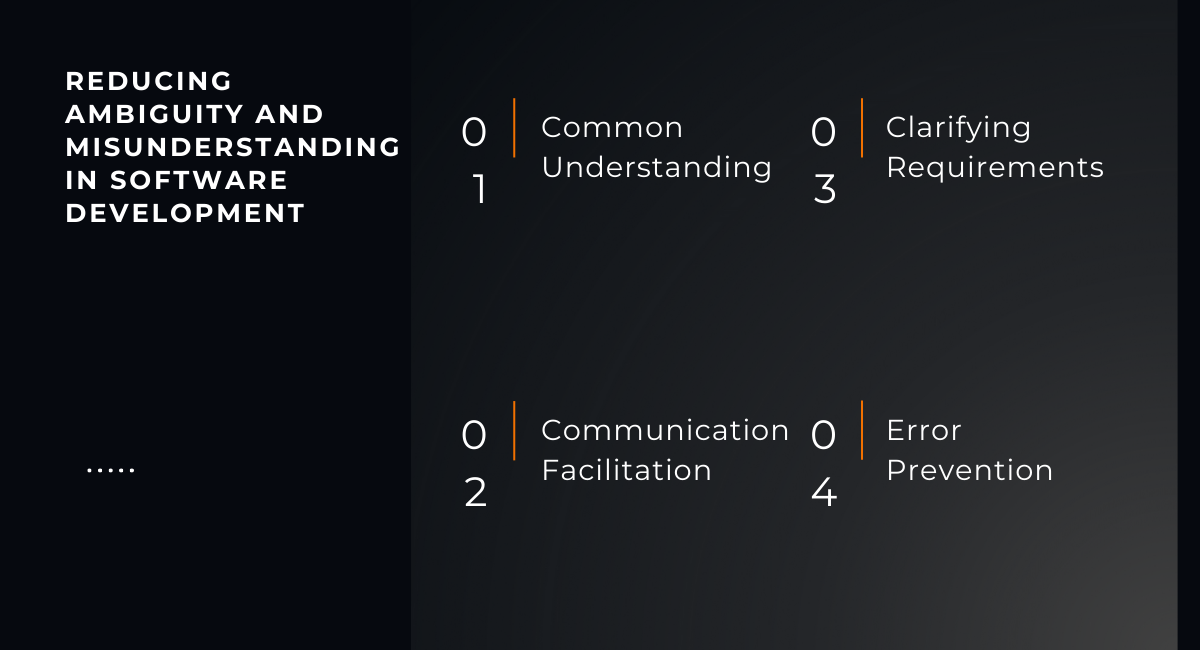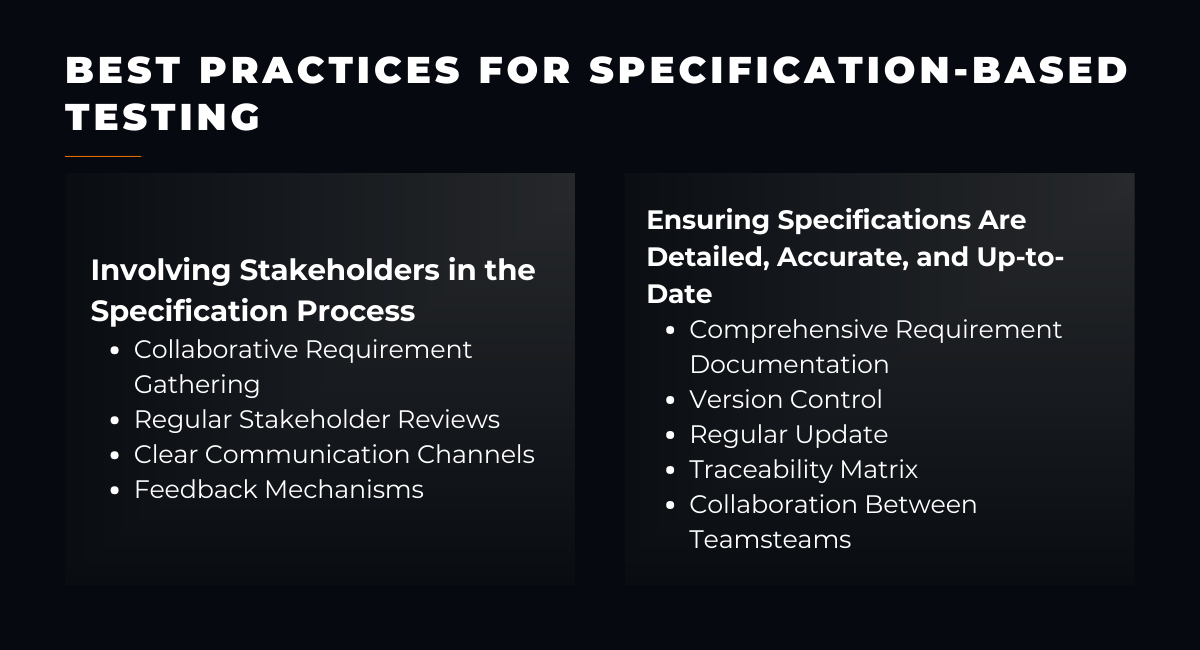Software testing is a crucial phase in the software development life cycle that involves systematically evaluating a software application to identify and rectify defects or errors. It is a process of validating and verifying that the software meets specified requirements and works as intended. Software testing aims to ensure the delivery of a reliable, high-quality product to end-users.
Testing can encompass various aspects of software, including functionality, performance, security, and usability. It is conducted through a combination of manual and automated techniques and plays a pivotal role in the overall software development process.
Critical Benefits of Specification-Based Testing
Precision and Clarity in Requirements

Specification-based testing contributes significantly to the precision and clarity of software requirements by aligning the testing process closely with the specified functionalities.
Here's how it achieves this:
Requirement Understanding:
A thorough analysis of the requirements is conducted before test cases are designed. Testers delve into what the software is expected to do, its inputs, expected outputs, and any constraints. This detailed understanding of requirements forms the foundation for constructing compelling test cases.
Traceability:
Test cases in specification-based testing are directly derived from the requirements. Each test case can be traced back to a specific set of requirements. This traceability ensures that the testing process accounts for every aspect of the software's functionality.
Test Case Design Techniques:
Specification-based testing often employs equivalence partitioning, boundary value analysis, and decision tables. These techniques help break down complex requirements into minor, manageable test cases, ensuring that each requirement is thoroughly tested in various scenarios.
Documentation:
As part of specification-based testing, detailed documentation is created for test cases, including input values, expected results, and execution steps. This documentation is a reference for both testers and developers, clearly showing what is being tested and how.
Reducing Ambiguity and Misunderstanding in Software Development

Common Understanding:
When test cases are derived directly from specifications, there is a common understanding between the testing team and other stakeholders, including developers and project managers. This shared understanding reduces the possibility of misinterpretation or ambiguity regarding what the software should accomplish.
Clarifying Requirements:
Any ambiguities or inconsistencies in the requirements are likely to be identified during the testing process. This feedback loop ensures that ambiguities are clarified and inconsistencies are addressed early in the development cycle, preventing misunderstandings that could lead to costly rework later.
Communication Facilitation:
Specification-based testing acts as a communication tool between different teams involved in software development. By referencing well-defined test cases based on specifications, developers can gain insights into how their code is expected to perform, fostering better collaboration and reducing the chance of divergent interpretations.
Error Prevention:
By identifying and addressing potential misunderstandings early in the process, specification-based testing helps prevent errors and deviations from requirements. This proactive approach contributes to the overall quality of the software by ensuring that the final product aligns closely with the intended specifications.
Best Practices for Specification-Based Testing

Involving Stakeholders in the Specification Process
Collaborative Requirement Gathering:
Actively involve stakeholders, including end-users, product managers, business analysts, and developers, in the requirement-gathering process. Their insights and perspectives are invaluable for creating comprehensive specifications that align with user expectations.
Regular Stakeholder Reviews:
Conduct regular reviews and walkthroughs of the specifications with stakeholders to gather feedback. This iterative process ensures that requirements are well-understood and accurately documented, reducing the risk of misunderstandings later in the development cycle.
Clear Communication Channels:
Establish communication channels between the testing team and stakeholders. This helps address questions, obtain clarifications, and ensure that any changes in requirements are promptly communicated and reflected in the testing process.
Feedback Mechanisms:
Encourage stakeholders to provide feedback on the test cases derived from the specifications. Their feedback can reveal additional perspectives and potential scenarios that may have been overlooked, contributing to a more thorough testing process.
Ensuring Specifications Are Detailed, Accurate, and Up-to-Date
Comprehensive Requirement Documentation:
Create detailed and comprehensive requirement documents that cover all aspects of the software's functionality. Specify inputs, expected outputs, business rules, and any constraints. The more detailed the specifications, the more influential the derived test cases will be.
Version Control:
Implement version control mechanisms for specifications to ensure all team members work with the latest and most accurate information. This helps avoid confusion arising from outdated or conflicting specifications and ensures that testing efforts are aligned with the project's current state.
Regular Updates:
Specifications should be living documents that are updated regularly to reflect any changes in requirements or project scope. This ensures that the testing team always has the most accurate information, reducing the risk of testing against outdated specifications.
Traceability Matrix:
Maintain a traceability matrix that links each requirement to the corresponding test case. This matrix helps verify that all requirements have associated test coverage and allows for easy identification of gaps or missing test cases.
Collaboration Between Teams:
Collaborate with development and testing teams to keep specifications synchronized with the evolving codebase. Regular meetings and communication channels can facilitate the exchange of information and ensure that any changes in the software are accurately reflected in the specifications.
Challenges and Solutions
Common Challenges in Specification-Based Testing
Potential Issues with Incomplete or Unclear Specifications
Ambiguities and Vagueness:
Specifications may lack clarity, leading to ambiguities that can result in misinterpretation by testing and development teams.
Missing Details:
Incomplete specifications may not provide all the necessary details, making it challenging to create comprehensive test cases.
Changing Requirements:
Specifications may evolve, and changes may not be communicated effectively to the testing team, leading to discrepancies.
Managing Changes in Specifications During the Development Process
Scope Creep:
Changes in project scope or requirements during development can introduce challenges, primarily when ongoing testing efforts are based on earlier specifications.
Communication Gaps:
Inadequate communication about specification changes can lead to the testing team working with outdated information.
Strategies to Overcome Challenges
Collaboration Between Development and Testing Teams
Regular Meetings:
Conduct meetings between development and testing teams to discuss specifications, clarify doubts, and ensure a shared understanding of requirements.
Joint Requirement Reviews:
Encourage common requirement reviews where both development and testing teams participate. This facilitates early identification of potential issues and promotes a collaborative approach to refining specifications.
Use of Collaboration Tools:
Employ collaboration tools that enable real-time communication and document sharing. This ensures that both teams can access the latest specifications and that any updates are communicated promptly.
Cross-Training:
Promote cross-training between testing and development teams to enhance mutual understanding. This helps testers better comprehend the development process, and developers gain insights into the testing perspective.
Continuous Improvement of the Specification Process
Feedback Loops:
Establish feedback loops between stakeholders, including end-users, and the teams involved in specification creation. This helps identify improvement areas and ensures that specifications accurately reflect user expectations.
Iterative Reviews:
Conduct iterative reviews of specifications at different stages of the development life cycle. This allows for adjustments based on evolving project needs and reduces the likelihood of incomplete or unclear specifications.
Training and Skill Development:
Invest in training programs to enhance the skills of both development and testing teams in requirements analysis and specification creation. Improved proficiency in these areas contributes to better-quality specifications.
Documentation Standards:
Define and adhere to documentation standards for specifications. Consistent and standardized documentation practices make it easier for teams to understand and work with specifications, reducing the risk of misunderstandings.
By addressing these challenges through collaboration, effective communication, and continuous improvement, organizations can enhance the reliability and effectiveness of specification-based testing. This, in turn, contributes to the overall success of the software development process.
Boost Performance
The adoption of specification-based testing is a strategic investment that ensures the current success of software projects and lays the foundation for sustained excellence and customer satisfaction in the ever-evolving landscape of software development.
You may also be interested in Other Feature for Software Testing | ContextQA
Book a Demo and experience ContextQA testing tool in action with a complimentary, no-obligation session tailored to your business needs.
We make it easy to start with the ContextQA tool: Start Free Trial.
